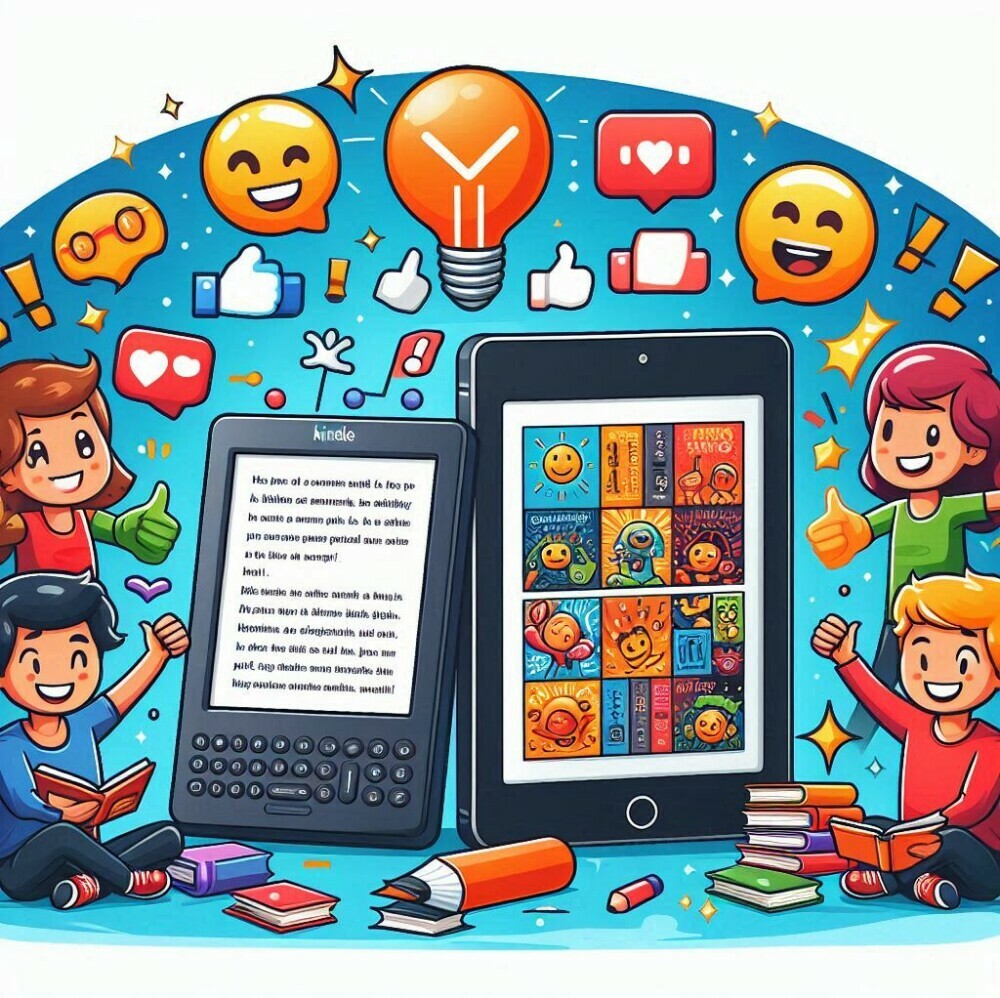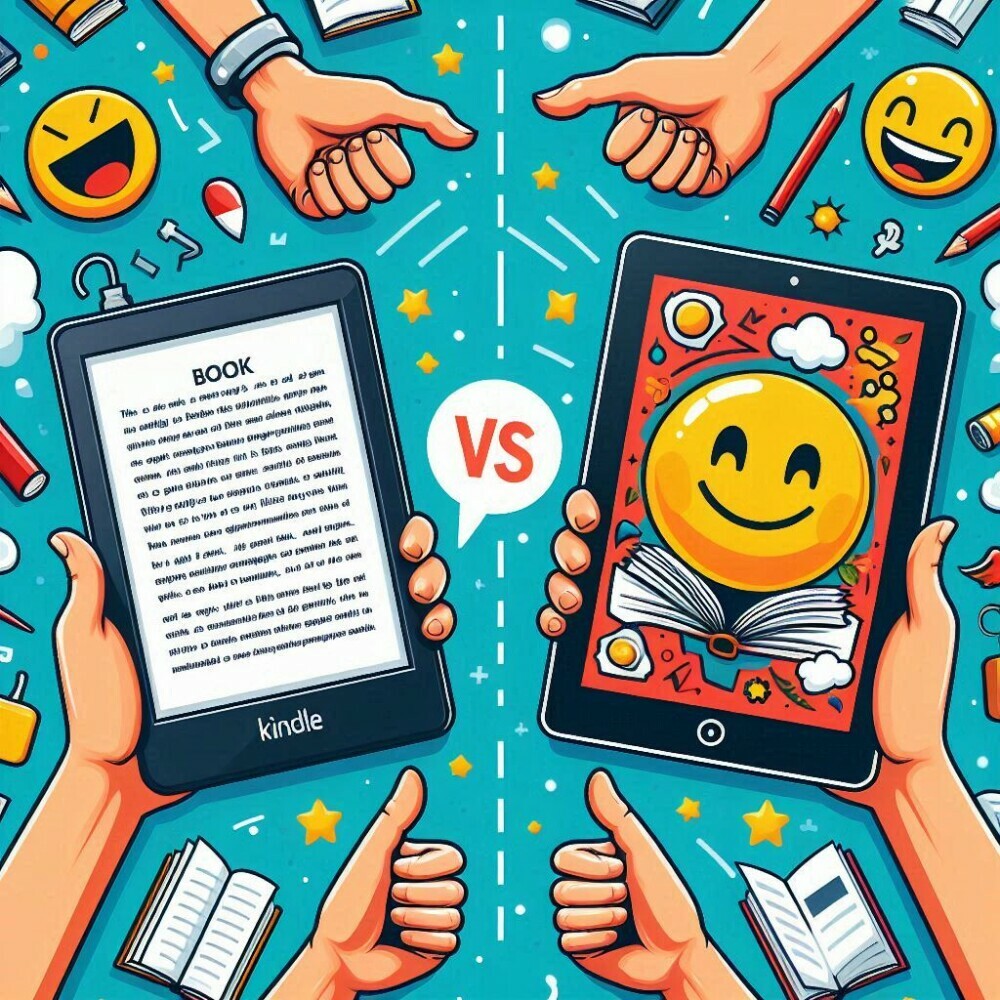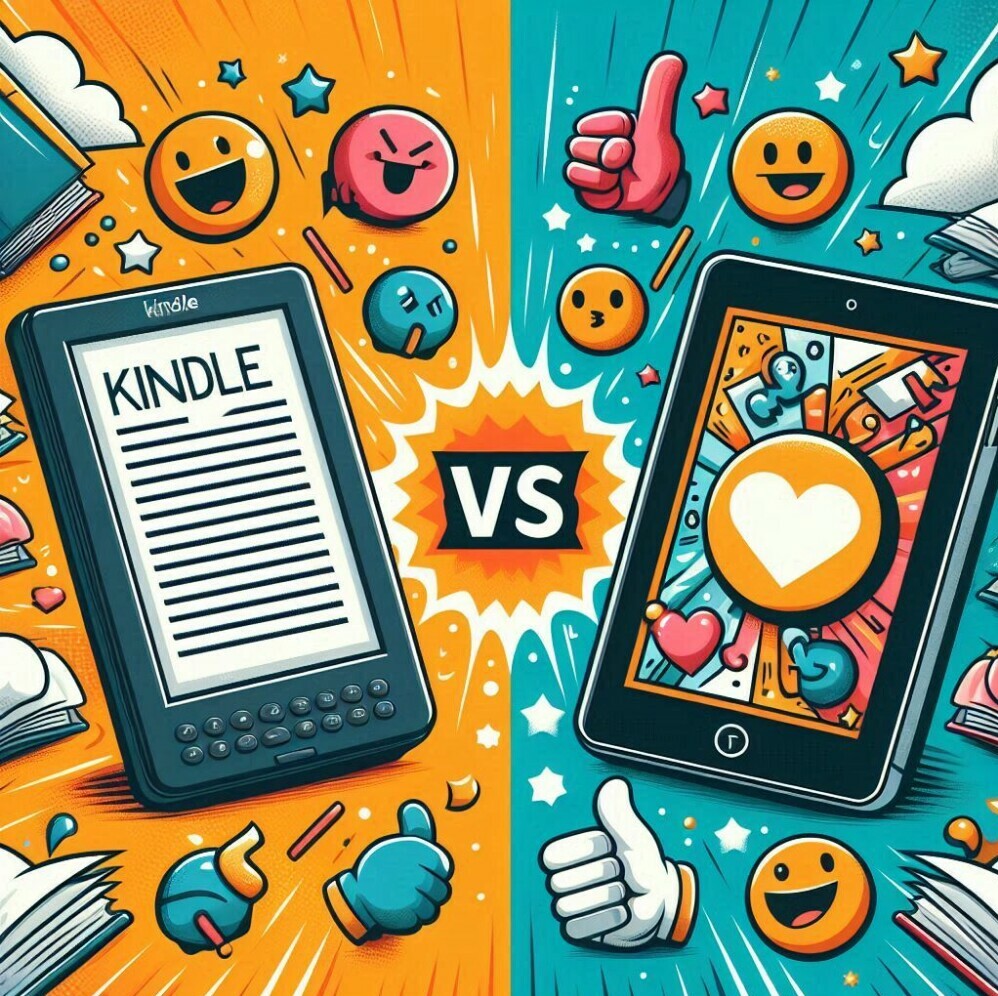
In the digital age, the debate of Kindle vs Apple Books has become a significant discussion among readers worldwide. As two of the leading platforms in the e-reading market, each offers unique features and benefits that appeal to different audiences. Whether you prefer the vast selection of Amazon Kindle or the integrated experience of Apple Books on your iPad, choosing the right platform can profoundly affect your reading habits and book access. This ongoing comparison not only captures the essence of ebook consumption today but also highlights the evolving preferences of readers in a tech-driven landscape.
This article delves into several critical aspects to help readers navigate the choice between Kindle and Apple Books. Starting with an overview of both platforms, it explores the user interface and experience, which is crucial for those using the Kindle app vs Apple Books on iPad. The comparison extends to library and book selection, examining which offers a more extensive or quality collection, including titles available through Amazon and iBooks. Pricing and subscription models are also evaluated to understand the value each platform provides, considering elements like Amazon Prime’s Audible vs Apple Books options. Finally, the article concludes with recommendations to guide readers in choosing the e-reading platform that best suits their needs, whether they are swayed by the Kindle Books vs Apple Books debate or are comparing the broader ecosystem of Apple Books vs Kindle Library.
Overview of Kindle and Apple Books
Kindle Ecosystem
The Kindle ecosystem offers a highly versatile reading experience across various devices, not limited to Amazon’s own hardware. Users can access Kindle books on Apple devices, providing flexibility in how and where they read. This cross-platform compatibility is a significant advantage for users who might switch between different types of devices. Amazon’s approach to e-reading is centred around accessibility, with the Kindle app available on phones and desktop computers, allowing users to maintain a seamless reading experience across all their devices. Additionally, Amazon has been enhancing its value proposition with Kindle rewards, which offer savings on book purchases, making it an economically attractive option for avid readers.
Apple Books Ecosystem
Conversely, Apple Books operates exclusively within the Apple ecosystem, limiting its accessibility to users of Apple devices only. This exclusivity can be a drawback for those who use a mix of technology from different brands or those considering moving away from Apple products in the future. The design and user interface of Apple Books are highly praised for their aesthetics and ease of use, especially with the integration of audiobooks and the ability to purchase books directly through the app. Apple Books also syncs seamlessly with other Apple devices, including the Apple Watch, enhancing the convenience for users deeply embedded in the Apple ecosystem.
Both platforms offer unique advantages depending on the users’ hardware preferences and reading habits. Kindle’s cross-platform flexibility and promotional offers make it appealing for those looking for economic value and versatility, while Apple Books’ integrated experience and stunning interface cater to users who appreciate a high-quality, cohesive product experience within the Apple ecosystem.

User Interface and Experience
Kindle Interface
The Kindle app offers a user-friendly interface that is accessible across various platforms, including iOS and Android devices. It features an intuitive homepage that displays the current book being read with a simple tap on the book icon at the bottom center of the screen, allowing users to quickly resume their reading. The library tab within the app provides an organized view of purchased books and samples, although it lacks some of the more advanced interactive features found in competing apps. Notably, the Kindle app does not support in-app purchases on iOS devices due to Amazon’s strategy to avoid transaction fees, requiring users to purchase books through a web browser or on non-Apple devices.
Apple Books Interface
Apple Books boasts a highly aesthetic and seamless interface, exclusive to iOS users. The app comes pre-installed on new Apple devices, and its integration with the Apple ecosystem enhances the overall user experience. Features like in-app purchases allow users to buy books directly within the app, adding to the convenience. Apple Books also includes unique functionalities such as a reading challenge feature, which encourages users to set and meet personal reading goals. The library management is superior, with options to suggest similar books based on user preferences or remove titles easily. This tailored approach, combined with the visually appealing design and smooth performance on Apple devices, makes Apple Books a favourite among dedicated Apple users.
Library and Book Selection
Kindle Bookstore
Amazon is recognized as the leading e-book seller globally, largely due to its extensive and diverse selection of e-books. The Kindle bookstore is known for its frequent specials on popular books, making it an attractive option for readers looking to build or expand their digital libraries economically. Users appreciate the Kindle’s compatibility across various devices, which allows them to purchase and read books on multiple platforms, including iPads. This flexibility is enhanced by Kindle’s file sizes, which are generally small and efficient; most e-books are in the range of 400-800kb, with larger texts like textbooks occasionally reaching up to 22 MB. This efficient use of space ensures that even users with older Kindle models or those with limited storage are unlikely to run out of space.
Apple Books Selection
In contrast, Apple Books offers a highly curated reading experience that is integrated seamlessly across all Apple devices. The platform is designed as a one-stop shop for Apple users, eliminating the need for additional subscriptions or applications. Apple Books excels in user experience, providing a clean and reliable interface where users can easily search for deals, bestsellers, and upcoming releases. The Top Charts and new trends sections are particularly popular, helping users discover books that are currently popular within the app. While Apple Books may not support library downloads like Kindle, its exclusive features and the convenience of direct purchases within the app make it a strong contender for dedicated Apple users.

Pricing and Subscription Models
Kindle Pricing and Subscriptions
Amazon’s Kindle store has been strategically priced to attract a broad audience. Historically, Amazon adopted a ‘loss leader’ strategy by selling Kindle e-books at prices lower than their wholesale costs to build market share and draw in readers. This approach allowed Kindle editions to be priced around $9.99, shaping consumer expectations for e-book costs. However, with deals struck in 2010, Amazon and major publishing houses agreed to the agency model, where publishers set the prices, aligning Kindle’s e-book pricing more closely with Apple’s model for major titles. For smaller publishers not under this model, Kindle e-books may still be priced lower than their iBookstore counterparts.
Amazon also enhances Kindle’s appeal with promotional offerings like Kindle rewards, providing significant savings on book purchases, which is an attractive perk for frequent buyers. Despite the lack of a subscription model specifically for e-books, Amazon does offer subscriptions through Amazon Prime, which includes access to Audible audiobooks and a rotating selection of free e-books.
Apple Books Pricing
Apple Books operates under the agency model, where publishers set the retail price of the e-books, and Apple takes a predetermined percentage of each sale. This model was initially adopted to provide a counterbalance to Amazon’s dominant market position and to help maintain higher price points in the digital book market. As a result, prices on Apple Books might appear slightly higher, especially for books from publishers who emphasize this pricing model to ensure a fair return on their content.
Apple does not offer a subscription model for its e-books or audiobooks, meaning each purchase is a one-time transaction. This straightforward approach ensures users pay for only the books they want without additional commitments or recurring fees. However, users have access to free books, including those from Project Gutenberg, which adds value to the platform.
In summary, both platforms offer distinct pricing strategies and benefits. Kindle provides a cost-effective approach with occasional promotions and rewards, while Apple Books maintains a premium pricing model with straightforward, per-purchase transactions. Each model attracts different user segments based on their reading habits and budget considerations.
Conclusion and Recommendations
Thus, the debate between Kindle and Apple Books illuminates divergent preferences and priorities among e-readers, underscoring the importance of selecting a platform that aligns with one’s reading habits, device ecosystem, and budgetary considerations. Kindle emerges as a versatile contender, celebrated for its cross-platform accessibility and economic incentives, appealing to those who prioritize flexibility and value. Conversely, Apple Books offers a polished, integrated experience within the Apple ecosystem, attracting users with its simplicity, design, and straightforward purchasing system. Each platform uniquely caters to its audience, highlighting the evolving dynamics of digital reading in a technology-driven era.
Reflecting on the broader implications of this comparison, it’s evident that the choice between Kindle and Apple Books is not merely about selecting an e-reading app but about embracing an ecosystem that enhances one’s reading journey. As technology continues to redefine our reading experiences, the consideration of future developments and potential shifts in e-reader preferences will be crucial. The ongoing evolution of features, accessibility, and content offerings from both platforms suggests a promising horizon for digital reading, encouraging readers to explore the dimensions of convenience, variety, and user engagement that resonate most profoundly with their individual reading ethos.

FAQs
1. Which device should I choose for reading books, Kindle or iPad?
If your primary purpose is reading e-books, opting for a Kindle is highly recommended. It is cost-effective, gentle on the eyes, boasts a long battery life, and offers access to an almost limitless e-book library. Kindle is particularly suited for avid readers.
2. Is reading on a Kindle preferable to reading physical books?
According to the Sam Holstein blog, there are several reasons why physical books might be considered superior to Kindles. These include the lower cost of physical books compared to the device, better retention of information when reading from a paper book, and the ease of reviewing notes in physical books.
3. Does Apple provide an e-reader?
While Apple does not manufacture a dedicated e-reader device, they offer a sleek e-reading app, originally known as iBooks, now available only on iOS devices. This app is an excellent option for those who prefer Apple’s ecosystem and works exceptionally well on iPads.
4. Is an iPad or a Kindle better for your eyes when reading?
iPads, which use a backlit screen, can lead to eyestrain if used for prolonged reading sessions, similar to the strain experienced with computer monitors. In contrast, reading on a Kindle is comparable to reading a physical book in terms of visual comfort.
A very interesting article. I enjoyed reading about the many and yet unknown differences between the two platforms. I appreciate your due diligence in researching and publishing this article. I use kindle on my I pad and smart phone. I am an avid reader and enjoy mysteries, history, and educational books. Your post here is very helpful and I am sure that readers will find it enlightening. Thank you very much.
Hey Walter,
Thank you so much for your kind words about the article! I’m thrilled to hear that you found it interesting and helpful. It’s great to know that you’re an avid reader and enjoy a variety of genres, including mysteries, history, and educational books. Using Kindle on your iPad and smartphone must make it convenient to access your favorite books on the go. I appreciate your appreciation for the research that went into the article, and I’m glad it could provide value to you and other readers.
Marios
This article provides a comprehensive comparison of Kindle and Apple Books, capturing the key differences in user experience and ecosystem integration. The Kindle’s cross-platform versatility and extensive book selection stand out, especially for users who appreciate economic value and frequent promotions. On the other hand, Apple Books excels in delivering a seamless, integrated experience with an aesthetically pleasing interface, ideal for those deeply embedded in the Apple ecosystem.
The detailed breakdown of user interface elements, library selection, and pricing models is particularly insightful. It helps potential users understand the practical implications of choosing one platform over the other, based on their hardware preferences and reading habits. The emphasis on unique features, like Kindle’s wide accessibility versus Apple Books’ in-app purchase convenience and reading challenges, adds depth to the analysis.
This comparison is a must-read for anyone trying to decide between these two major e-reading platforms. It effectively outlines the strengths and limitations of each, guiding readers to make an informed choice that aligns with their personal and technological ecosystem.
Hey Lizzy,
Thank you for the thoughtful feedback. The article’s comprehensive analysis of the key differences between Kindle and Apple Books provides a valuable framework for readers to evaluate which platform best suits their needs. The nuanced breakdown of factors like user experience, ecosystem integration, and feature sets allows readers to make an informed decision. Your feedback suggests the article successfully guided readers through the practical implications of choosing between these two major e-reading platforms.
Marios
Hello Marios,
This article provides a thorough and insightful comparison between Kindle and Apple Books, highlighting the key differences and unique features of each platform. The detailed breakdown of user interfaces, library selections and integration within their respective ecosystems offers a clear understanding of what each service has to offer.
I found the analysis of Kindle’s cross-platform flexibility and economic benefits particularly compelling. It is great to see how Kindle accommodates a range of devices and offers valuable promotions. On the other hand, Apple Books’ seamless integration with the Apple ecosystem and its aesthetically pleasing interface are strong points that could sway me deeply to invest in Apple products.
Thank you for sharing.
Hey Stralight!
Thank you for the thoughtful feedback on our Kindle vs. Apple Books comparison. I’m glad the detailed breakdown of key differences between the platforms was so insightful. Providing a comprehensive look at user interfaces, library selections, and ecosystem integration is crucial to help readers make an informed decision. The analysis of Kindle’s cross-platform flexibility and Apple Books’ seamless Apple integration was particularly compelling. Feedback like this lets us know we’re succeeding in creating a valuable resource to support ebook platform decisions. We appreciate you taking the time to share your perspective.
M.
I absolutely loved your comparison of Kindle and Apple Books! The way you broke down the strengths and weaknesses of each platform really helped clarify the differences, especially for someone like me who enjoys both reading and technology. Your insights on how Kindle offers cross-platform versatility while Apple Books shines in its seamless integration within the Apple ecosystem were spot on. It’s clear you’ve put a lot of thought into this, and it shows. Keep up the great work—I’m looking forward to reading more of your articles in the future!
Best regards,
Gabriel John
Thank you so much for your kind words, Gabriel! I’m thrilled to hear that you found the comparison helpful. It’s always a pleasure to explore the intersection of reading and technology, and I appreciate your recognition of the strengths of both platforms. Your support means a lot, and I’m excited to share more insights in the future. Stay tuned for more articles, and happy reading! Best regards!
M.
Great comparison between Kindle and Apple Books for e-reading! I’ve used both platforms and each has its strengths depending on what you’re looking for.
Kindle’s vast library and the focus on reading features are fantastic, while Apple Books integrates so seamlessly with other Apple devices. It’s always a tough choice!
Have you noticed a difference in your reading habits depending on the platform you use?
Hi Marlinda,
Thank you for your thoughtful comment! I completely agree that both Kindle and Apple Books have unique strengths that cater to different preferences. Personally, I’ve found that my reading habits do shift depending on the platform. With Kindle, I tend to read more often due to its extensive library and reading-focused features, while Apple Books makes it easy to enjoy audiobooks and sync across devices. It’s interesting how the platform can influence our reading experiences! How about you? Have you noticed any changes in your habits?
M.